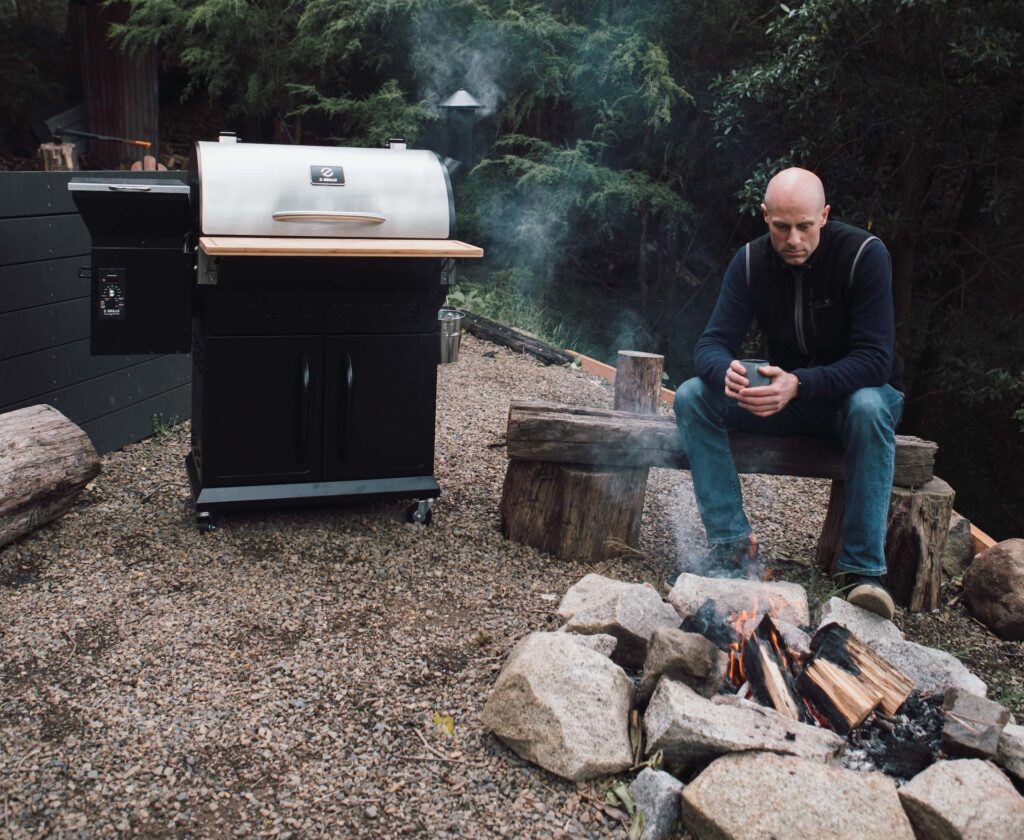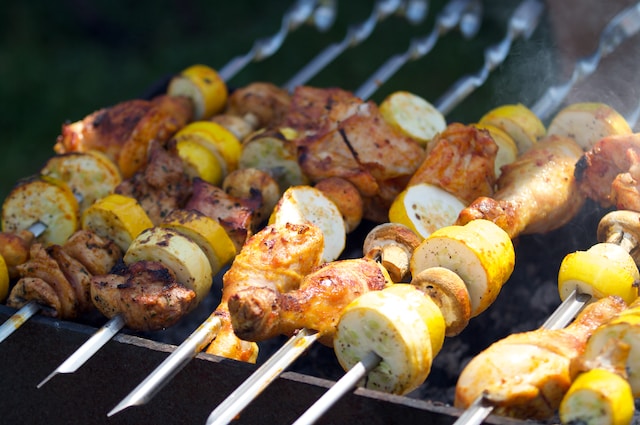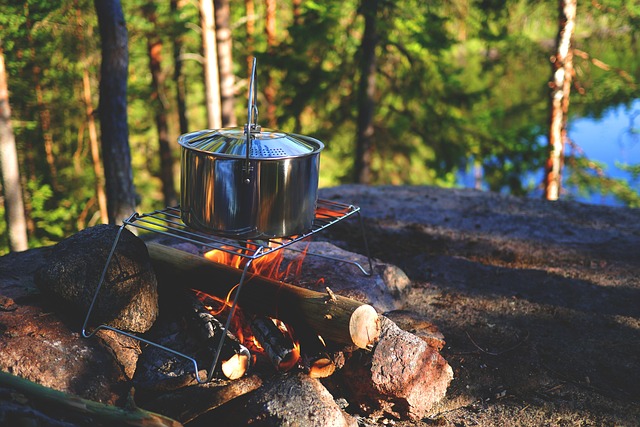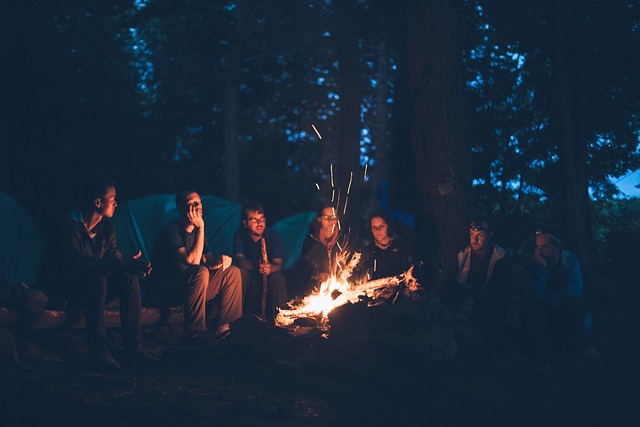Cooking in the Outdoors: A Delicious Adventure in Nature
Cooking in the outdoors is an unmatched experience every time. When you’re out in the wilderness, away from the conveniences of modern kitchens and the digital buzz of our modern world, we slow down and enjoy just being in nature.
Essential Tools for Every Outdoor Cook
Cooking in the outdoors calls for preparation. While being out in nature is spontaneous, few essential tools are good to have to make the experience memorable.
The Portable Grill:

The cornerstone of any outdoor cooking venture! A portable grill offers flexibility, from searing steaks to roasting veggies. Whether you’re at a campsite, on the beach, or tailgating, this compact wonder brings the power of a full-fledged BBQ wherever you go. Modern designs are not only lightweight but also efficient, ensuring that the food is cooked evenly. The result is a delightful charred flavor that indoor cooking often misses.
Fire-starting Essentials:
The soul of outdoor cooking lies in mastering the fire. While matches are old faithful, there are numerous fire-starting tools available now. Waterproof matches can resist damp environments. Firestarter kits, often containing magnesium or flint, provide a reliable spark in windy and rainy conditions.
Lightweight, Durable Cookware:
While the fire provides the heat, the right cookware ensures that your food is cooked to perfection even outdoors. Materials like cast iron can retain heat superbly, making them ideal for dishes that need consistent heat. For those keen on keeping their packs light, aluminum or titanium pots and pans are good choices. They are not only light but also conduct heat well. Remember, when cooking outdoors, lids for your pots are important. They not only make the cooking process fast by retaining heat but also keep pesky bugs and leaves out!
Recipes to Make Your Outdoor Adventure Delicious
Cooking in the outdoors are better when you have recipes that complement the environment. Here are two dishes that are not only delicious but also easy to prepare.
Campfire Skewers:
Nothing says outdoor cooking more than skewers. They’re fun, versatile, and delicious! Here’s a basic recipe with a twist:

| Ingredients | Quantity |
| Boneless chicken chunks or tofu | 500 grams |
| Bell peppers (red, yellow, green) | 1 each |
| Red onions | 2 (medium) |
| Cherry tomatoes | 200 grams |
| Zucchini | 1 (large) |
| Olive oil | 3 tablespoons |
| Minced garlic (for marinade) | 3 cloves |
| Lemon juice (for marinade) | 2 tablespoons |
| Fresh herbs (rosemary or thyme, for marinade) | 2 tablespoons, chopped |
| Salt and pepper (for marinade) | To taste |
Instructions:
1. In a mixing bowl, combine olive oil, minced garlic, lemon juice, chopped fresh herbs, salt, and pepper to create the marinade.
2. Add the chicken or tofu pieces to the marinade, ensuring they’re well-coated. Let it sit for at least 30 minutes.
3. Alternately thread marinated chicken or tofu and vegetables onto skewers.
4. Place skewers over the campfire grill or directly on embers for a smoky flavor.
5. Rotate skewers occasionally, ensuring even cooking. Grill for about 10-15 minutes.
6. Serve with pita bread or a fresh salad.
Pro Tip: Soak wooden skewers in water for about 30 minutes before threading to prevent them from burning.
One-Pot Campfire Stew:
There’s something deeply comforting about a warm, hearty stew under the open sky.

| Ingredients | Quantity |
| Stewing beef chunks | 500 grams |
| Carrots | 3 (medium) |
| Potatoes | 3 (medium) |
| Onion | 1 (large) |
| Garlic cloves | 3 |
| Beef or vegetable broth | 1 liter |
| Salt | To taste |
| Pepper | To taste |
| Fresh rosemary or thyme | 2 sprigs |
| Olive oil | 2 tablespoons |
Instructions:
1. In a heavy-bottomed pot or Dutch oven, heat olive oil over the campfire.
2. Add beef chunks and brown on all sides.
3. Toss in chopped onions and minced garlic, sautéing until onions are translucent.
4. Add chopped carrots and potatoes to the pot.
5. Pour in the beef or vegetable broth, ensuring the ingredients are submerged. Season with salt, pepper and herbs.
6. Cover the pot and let it simmer over a gentle flame for 1-2 hours, or until meat and vegetables are tender.
7. Adjust seasoning if necessary and serve hot.
Pro Tip: For a thicker stew, you can mix some flour with water to create a slurry and add it to the pot in the last 20 minutes of cooking.
Benefits of Cooking in the Open Air
When you cook outdoors, it’s not just the food that becomes the highlight, but the entire experience that surrounds it. The vast open sky above, the fresh breeze, and the natural setting play as much a role in the meal as the ingredients themselves.
Fresh Ingredients, Fresh Air
There’s a stark difference between cooking in a closed kitchen and the open wilderness. When outdoors, you’re often closer to the source of your food. Whether it’s fish you’ve just caught from a nearby stream or wild berries picked from a bush, the freshness of these ingredients is incomparable. The open-air environment enhances the sensory pleasure of cooking. The combination of fresh ingredients and the surrounding fresh air makes every bite a delightful sensory experience.
Bonding over Bonfires
Cooking in the outdoors, especially around a bonfire, is an inherently communal activity. It’s not just about the food but also about the shared moments that lead up to the meal. The collective effort of gathering wood, starting the fire, prepping the ingredients, and finally cooking creates a sense of teamwork and unity.
As the fire is lit and the food simmers, stories are shared, songs are sung, and memories are made. The warm glow of the fire becomes a backdrop for deep conversations and hearty laughter. It’s these shared experiences and memories that often become more cherished than the meal itself. In today’s digital age, where distractions are abundant, a bonfire gathering offers a rare moment of disconnect from gadgets and a reconnection with fellow humans. It reminds us of simpler times and the joys of being present in the moment.

Safety First! Tips for Safe Outdoor Cooking
Cooking in the outdoors, while delightful and memorable, can pose certain challenges that aren’t typically present in our safe kitchen environments. From unpredictable weather to wildlife, safety must always be at the forefront of any outdoor culinary adventure. Here are some vital tips to ensure you and your companions stay safe while enjoying your outdoor feast:
1. Choose Your Cooking Spot Wisely
Distance from Flammable Materials: Set up your cooking spot at least 10 feet away from tents, dry leaves, and other flammable materials.
Ground Level: Ensure the ground is level to prevent any cooking equipment from tipping over.
2. Monitor the Weather
Be mindful of weather conditions. Wind can blow embers, potentially causing wildfires. If it’s too windy, consider postponing your cooking or find a more sheltered spot. Rain can also extinguish your fire and make cooking difficult.
3. Fire Safety
Clear the Area: Before starting a fire, clear a 10-foot diameter area down to the soil.
Never Leave it Unattended: An unattended fire can escalate quickly. Always have someone monitor it.
Extinguish Properly: When done, douse the fire with water, stir the ashes, and douse again. Make sure it’s cold to touch before leaving.
4. Store Food Properly
To prevent wildlife encounters, store food in airtight containers. If in bear country, use bear-proof containers or hang your food at least 10 feet off the ground and 4 feet away from any tree trunk.
5. Be Cautious with Fuel
If using propane or liquid fuel stoves, check for leaks and keep the fuel container away from the stove while it’s on. Always have a fire extinguisher or water source nearby.
6. Protect Yourself
Dress Appropriately: Wear non-synthetic clothes, as they can melt when exposed to heat. Use closed-toed shoes and avoid loose clothing.
Use Cooking Gloves: Protect your hands from hot surfaces and splattering oil.
7. Safe Water Source
It is not advisable, but if you’re sourcing water from a stream or lake, always boil it for at least one minute to kill pathogens, or use water purification tablets.
8. Avoid Cross-Contamination
Keep raw and cooked foods separate. Use different plates and utensils for raw meat and cooked dishes. Always wash your hands before and after handling food.
9. Food Temperature
When cooking meats, ensure they reach the appropriate internal temperatures to kill bacteria. Carry a meat thermometer to be sure.
Conclusion
Whether you’re a seasoned chef seeking new adventures or a nature enthusiast exploring the delightful world of outdoor cooking, the great outdoors welcomes you with a variety of flavors and experiences. With every dish you prepare under the open sky, you’re not just cooking but also creating memories, bonding over shared meals, and embracing the beauty of the wilderness. Safety, innovation, and the joy of experimenting with different methods make outdoor cooking a continually evolving journey.
FAQs
1. Is outdoor cooking safe for the environment?
Outdoor cooking can be environmentally friendly, provided you take a few precautions. Always use sustainable fuel sources and avoid cooking under trees or near dry grass to prevent forest fires. When using charcoal, opt for lump charcoal made from sustainable sources instead of briquettes, which can have additives. And of course, always pack out your trash and leave no trace.
2. How do I maintain a consistent temperature while cooking outdoors?
Maintaining a consistent temperature while cooking outdoors, especially on a campfire or charcoal grill, can be a bit tricky but it’s manageable. Use a cooking thermometer to monitor the temperature. Adjust the amount of fuel (wood or charcoal) and control the airflow using vents (if using a grill). If using a campfire, shifting your cooking grate closer or further from the flame can also help regulate heat.
3. What’s the best way to start a campfire for cooking?
To start a campfire for cooking, first, ensure you’re in a safe and permitted area. Begin with a fire starter or crumpled newspaper, adding small twigs and then progressively larger pieces of wood as the fire grows. Once you have a good flame going, let it burn down to coals. This provides a more even and manageable heat source for cooking.
4. Are portable grills worth the investment for occasional campers?
For occasional campers, it depends on the kind of culinary experience you’re aiming for. While a campfire suffices for most basic cooking, a portable grill offers better temperature control and versatility. If you foresee multiple outdoor cooking sessions or value convenience and a broader range of dishes, then a portable grill is a worthwhile investment.
5. Can I cook the same recipes outdoors as I do indoors?
While you can recreate many indoor recipes outdoors, there might be some modifications needed depending on your heat source. Outdoor cooking often requires adapting to uneven heat and varying temperatures. However, this can also open the door to innovative dishes and flavors unique to outdoor cooking.





Comments are closed.